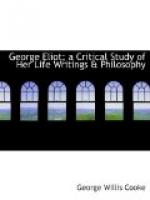To this special theory of the novel, as it had been worked out by the English masters of prose-poetry, George Eliot added nothing essential. Thackeray, Mrs. Gaskell, Miss Austen, Miss Mitford, Fielding and Richardson had preceded her along the way she was to follow. Their methods became hers, she accepted their influence, and her work was done in the spirit they had so ably illustrated. In one direction, however, she far surpassed any one of her masters, and gave to the novel a richness of power and fulness of aim it had not attained to with any of her predecessors. George Eliot combined other methods with that of naturalism, not adhering rigidly to the purpose of painting life as it appears on the surface. Not only from the pre-Raphaelites, but from such romanticists as Scott, did she learn much. Past scenes became natural, and history was discovered to be a vast element in the thought of the present. Scott’s power of reviving the past in all its romantic and picturesque features, which gave him such capacity for re-creating the life that had once passed away, was not possessed by George Eliot. Still, if not a romancist, she realized how mighty is the shaping power of the past over the present. For this reason, she endeavored to recast old scenes, to revive in living shapes the times that had gone by. The living movements of the present, its efforts at reform, its cries for liberty, its searchings after a freer and purer life, also became a prominent element in her novels. If in this tendency she somewhat enlarged upon the methods of her masters, yet she was quite in sympathy with many who came just before her, and with many more who were her contemporaries. In another direction she kept along the way followed by many of her co-workers, and brought philosophy and socialistic speculation to the aid of the naturalistic method. Indeed, she so far departed from that method, and from the soundest theories of art, as to become to some extent a doctrinaire.




